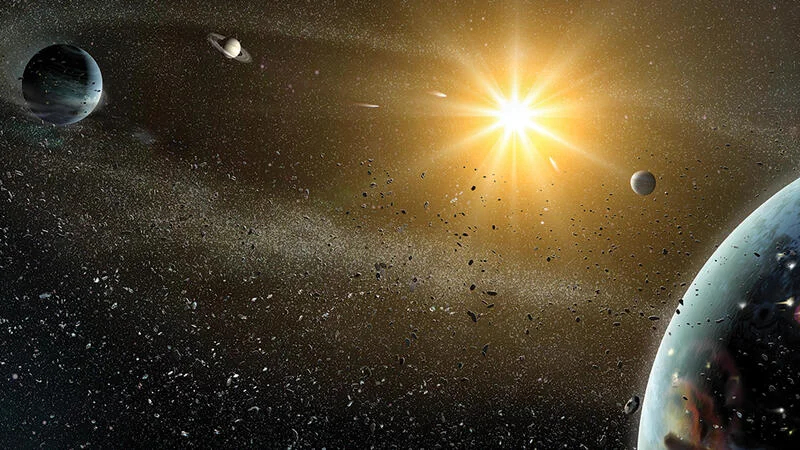Bullying Jupiter-like planets may push 'alien Earths' away from life-friendly orbits
Want life? Don't get too close to a gas giant planet.

Like huge playground bullies, planets like Jupiter can be "agents of chaos" around other stars, a pair of new studies suggest.
Gas giant planets that are the size of Jupiter or larger create havoc in young planetary systems, often shoving smaller, Earth-sized planets way out of their original, circular orbits, according to the new research.
All this instability spells bad news for life on terrestrial planets, as organisms need stable conditions to take root and flourish. Just watch the 2011 film "Melancholia" to get the idea: a planet — once hit by, or veering too close to, a neighbor — will see its climate permanently destabilize.
Take the nightmare scenario of four giant planets that orbit a star known as HD 141399. "It's as if they have four Jupiters acting like wrecking balls, throwing everything out of whack," Stephen Kane, an astrophysicist at the University of California, Riverside (UCR) who authored one of the new studies, said in a Wednesday (Oct. 31) statement.
Related: These 10 super extreme exoplanets are out of this world
While the planetary quartet is relatively far from their star, their presence still would be bad news for an Earth-like planet in the habitable zone (the approximate orbital range where liquid water would be feasible on a terrestrial world's surface).
Computer simulations showed that Earth would have a tough time staying viable with so many big planets nearby. "It's very unlikely," said Kane. "There are only a select few areas where the giants' gravitational pull would not knock a rocky planet out of its orbit and send it flying right out of the zone."
Get the Space.com Newsletter
Breaking space news, the latest updates on rocket launches, skywatching events and more!
Luckily, Earth doesn't have that kind of "Hunger Games" energy to worry about. In fact, Jupiter's presence in our neighborhood is a boon. The gas giant's strong gravity acts more like a shield, bouncing away comets or asteroids that would otherwise beeline for our little world. But if Jupiter were in the middle of our habitable zone, our solar system might be a lot different.
A star just 30 light-years away from Earth, called GJ 357, was scrutinized in a second, related study t. (By comparison, Alpha Centauri — the closest planetary system to us — is roughly four light-years away.)
New estimates of a habitable zone planet, known as GJ 357 d, show that it's perhaps 10 times more massive than Earth, nearly double the previous estimate. Such a heavyweight would likely prevent Earth-size planets from safely sailing nearby, unless the smaller planet's orbit was highly elliptical — meaning that the world careens close and then zings far away from its parent star on its pathway in space.
"In other words, the orbits would produce crazy climates on those planets," said Kane, who co-authored the second study with UCR postdoctoral scholar Tara Fetherolf. "This paper is really a warning, when we find planets in the habitable zone, not to assume they are automatically capable of hosting life."
Both of these planetary systems show what could have happened to us if we had too many Jupiters in our neighborhood, or a single Jupiter that came too close. "Our work gives us more reasons to be very grateful for the particular planetary configuration we have in our solar system," Kane said.
Both studies were published last month in The Astronomical Journal. You can find them here and here.
Join our Space Forums to keep talking space on the latest missions, night sky and more! And if you have a news tip, correction or comment, let us know at: community@space.com.

Elizabeth Howell (she/her), Ph.D., was a staff writer in the spaceflight channel between 2022 and 2024 specializing in Canadian space news. She was contributing writer for Space.com for 10 years from 2012 to 2024. Elizabeth's reporting includes multiple exclusives with the White House, leading world coverage about a lost-and-found space tomato on the International Space Station, witnessing five human spaceflight launches on two continents, flying parabolic, working inside a spacesuit, and participating in a simulated Mars mission. Her latest book, "Why Am I Taller?" (ECW Press, 2022) is co-written with astronaut Dave Williams.
-
rod Some interesting info and points made in this space.com report. I read this article too at https://phys.org/news/2023-10-giant-planets-deadly-pall-life.htmlReply
"Kane said. "This paper is really a warning, when we find planets in the habitable zone, not to assume they are automatically capable of hosting life." Ultimately, the pair of papers shows how uncommon it is to find the right set of circumstances to host life elsewhere in the universe. "Our work gives us more reasons to be very grateful for the particular planetary configuration we have in our solar system," Kane said."
Ref - Surrounded by Giants: Habitable Zone Stability Within the HD 141399 System, https://iopscience.iop.org/article/10.3847/1538-3881/acfb01, 10-Oct-2023. "Abstract The search for exoplanets has revealed a diversity of planetary system architectures, the vast majority of which diverge significantly from the template of the solar system. In particular, giant planets beyond the snow line are relatively rare, especially for low-mass stars, placing the solar system within a small category of systems with multiple giant planets at large separations. An exoplanetary system of note is that of HD 141399, consisting of a K-dwarf host star that harbors four giant planets with separations extending to ∼4.5 au. The architecture of the system creates a complex pattern of mean motion resonances and gravitationally perturbed regions that may exclude the presence of other planets, including within the habitable zone of the system..."
Another parameter or factor to use when discussing astrobiology and searches for ET phoning home.









